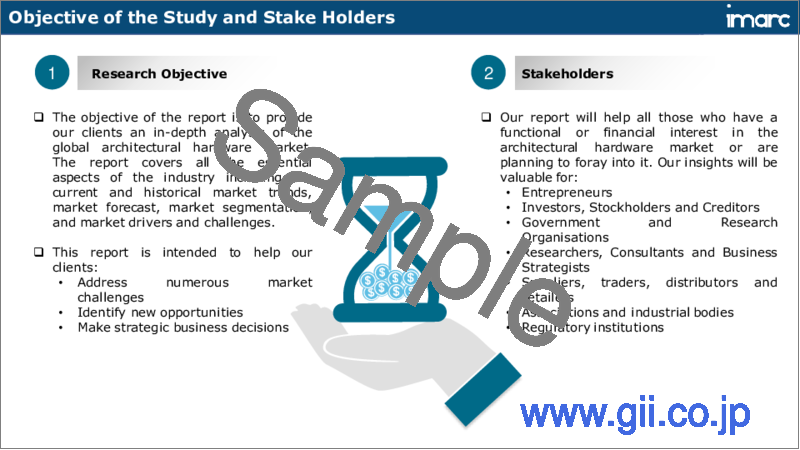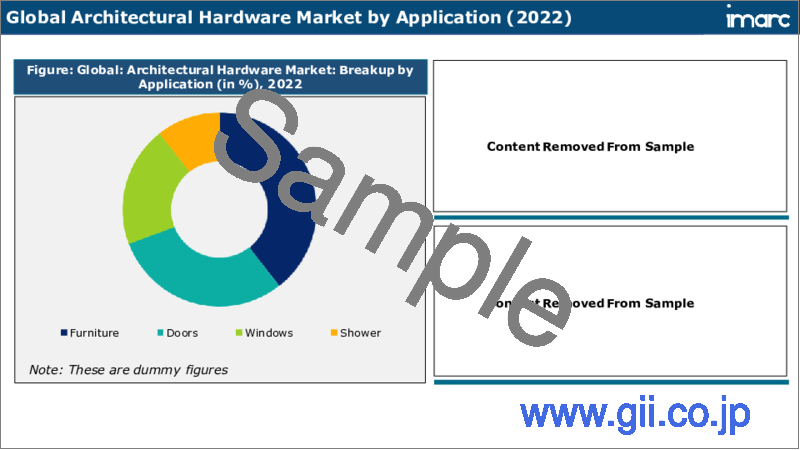|
|
市場調査レポート
商品コード
1370511
建築金物市場:世界の産業動向、シェア、規模、成長、機会、2023-2028年予測Architectural Hardware Market: Global Industry Trends, Share, Size, Growth, Opportunity and Forecast 2023-2028 |
||||||
|
● お客様のご希望に応じて、既存データの加工や未掲載情報(例:国別セグメント)の追加などの対応が可能です。 詳細はお問い合わせください。 |
|||||||
| 建築金物市場:世界の産業動向、シェア、規模、成長、機会、2023-2028年予測 |
|
出版日: 2023年10月15日
発行: IMARC
ページ情報: 英文 146 Pages
納期: 2~3営業日
|
- 全表示
- 概要
- 図表
- 目次
概要
市場概要:
世界の建築金物市場規模は、2022年に171億米ドルに達しました。今後、IMARC Groupは、2023年から2028年にかけて4.9%の成長率(CAGR)を示し、2028年までに231億米ドルに達すると予測しています。
建築金物は、建物や住宅の建設に使用される製品を指します。ドアハンドル、ロック、ヒンジ、ラッチ、ノブ、床バネ、家具用金具、パニックバー、ガラス用金具手すりなどが含まれます。一般的には、真鍮、スチール、アルミニウム、ステンレス、鉄などを使って製造されます。建築金物は、ドア、窓、シャワーに開閉、ロック機能を追加するために広く使用されています。耐久性と使い勝手に優れ、美観を向上させ、利便性を高め、住宅や建物のセキュリティと安全性を高める。
建築金物市場の動向:
世界の建設産業の著しい成長が、市場に明るい見通しをもたらしています。建築金物は、部屋、キッチン、バスルーム、ランドリーに欠かせないドア、窓、配管、家具の施工に広く使用されています。これに伴い、空港、港湾、教育機関、ヘルスケア施設、公園、スタジアムなどのインフラ開発活動が活発化していることも成長を促す要因となっています。さらに、消費者の嗜好が装飾的な金具から現代的なパターンへと変化し、見た目の美しさが向上していることや、ユニークな色、質感、デザイン、素材の洗練された豪華な金具が発売されていることも、市場の成長にプラスの影響を与えています。これとは別に、デジタルロックやドアビューアなど、使い勝手が良く、スマートフォンによるリモートアクセスを提供し、住宅、ガレージ、その他の建物のセキュリティを強化するスマート建築ハードウェアのイントロダクションが、市場に推進力を与えています。さらに、メーカーは、マットな質感で磨かれた建築金物、真鍮、ニッケル、ブロンズ仕上げ、さまざまな幾何学的形状やパターンで利用可能なクリスタルとサテンの外観を導入しており、これが市場の成長を促進しています。その他の要因としては、不動産分野への投資の増加、歴史的建造物や公共インフラの改修・再建の増加、スマートビルやグリーンビルの建設の著しい増加、広範な研究開発(R&D)活動などがあり、市場の成長を促進すると予測されます。
本レポートで扱う主な質問
- 世界の建築金物市場はこれまでどのように推移し、今後数年間はどのように推移するのか?
- COVID-19が世界の建築金物市場に与えた影響は?
- 主要な地域市場は?
- 用途別の市場内訳は?
- エンドユーザー別の市場内訳は?
- 業界のバリューチェーンにおける様々な段階とは?
- 業界の主要な促進要因と課題は何か?
- 世界の建築金物市場の構造と主要プレーヤーは?
- 業界の競合の程度は?
目次
第1章 序文
第2章 調査範囲と調査手法
- 調査目的
- 利害関係者
- データソース
- 一次情報
- 二次情報
- 市場推定
- ボトムアップアプローチ
- トップダウンアプローチ
- 調査手法
第3章 エグゼクティブサマリー
第4章 イントロダクション
- 概要
- 主要産業動向
第5章 世界の建築金物市場
- 市場概要
- 市場実績
- COVID-19の影響
- 市場予測
第6章 市場内訳:用途別
- 家具
- 市場動向
- 市場予測
- ドア
- 市場動向
- 市場予測
- 窓
- 市場動向
- 市場予測
- シャワー
- 市場動向
- 市場予測
第7章 市場内訳:エンドユーザー別
- 住宅
- 市場動向
- 市場予測
- 商業
- 市場動向
- 市場予測
- 産業
- 市場動向
- 市場予測
第8章 市場内訳:地域別
- 北米
- 米国
- 市場動向
- 市場予測
- カナダ
- 市場動向
- 市場予測
- 米国
- アジア太平洋
- 中国
- 市場動向
- 市場予測
- 日本
- 市場動向
- 市場予測
- インド
- 市場動向
- 市場予測
- 韓国
- 市場動向
- 市場予測
- オーストラリア
- 市場動向
- 市場予測
- インドネシア
- 市場動向
- 市場予測
- その他
- 市場動向
- 市場予測
- 中国
- 欧州
- ドイツ
- 市場動向
- 市場予測
- フランス
- 市場動向
- 市場予測
- 英国
- 市場動向
- 市場予測
- イタリア
- 市場動向
- 市場予測
- スペイン
- 市場動向
- 市場予測
- ロシア
- 市場動向
- 市場予測
- その他
- 市場動向
- 市場予測
- ドイツ
- ラテンアメリカ
- ブラジル
- 市場動向
- 市場予測
- メキシコ
- 市場動向
- 市場予測
- その他
- 市場動向
- 市場予測
- ブラジル
- 中東・アフリカ地域
- 市場動向
- 市場内訳:国別
- 市場予測
第9章 SWOT分析
- 概要
- 強み
- 弱み
- 機会
- 脅威
第10章 バリューチェーン分析
第11章 ポーターのファイブフォース分析
- 概要
- 買い手の交渉力
- 供給企業の交渉力
- 競合の程度
- 新規参入業者の脅威
- 代替品の脅威
第12章 価格分析
第13章 競合情勢
- 市場構造
- 主要企業
- 主要企業のプロファイル
- Allegion plc
- Assa Abloy AB
- Bohle Ltd.
- CRH plc
- Godrej & Boyce Mfg. Co. Ltd.
- Hafele GmbH & Co KG
- Hettich Holding GmbH and Co. oHG
- HOPPE Holding AG
- Spectrum Brands Inc.
- Taiwan Fu Hsing Industrial Co. Ltd.
List of Figures
- Figure 1: Global: Architectural Hardware Market: Major Drivers and Challenges
- Figure 2: Global: Architectural Hardware Market: Sales Value (in Billion US$), 2017-2022
- Figure 3: Global: Architectural Hardware Market Forecast: Sales Value (in Billion US$), 2023-2028
- Figure 4: Global: Architectural Hardware Market: Breakup by Application (in %), 2022
- Figure 5: Global: Architectural Hardware Market: Breakup by End User (in %), 2022
- Figure 6: Global: Architectural Hardware Market: Breakup by Region (in %), 2022
- Figure 7: Global: Architectural Hardware (Furniture) Market: Sales Value (in Million US$), 2017 & 2022
- Figure 8: Global: Architectural Hardware (Furniture) Market Forecast: Sales Value (in Million US$), 2023-2028
- Figure 9: Global: Architectural Hardware (Doors) Market: Sales Value (in Million US$), 2017 & 2022
- Figure 10: Global: Architectural Hardware (Doors) Market Forecast: Sales Value (in Million US$), 2023-2028
- Figure 11: Global: Architectural Hardware (Windows) Market: Sales Value (in Million US$), 2017 & 2022
- Figure 12: Global: Architectural Hardware (Windows) Market Forecast: Sales Value (in Million US$), 2023-2028
- Figure 13: Global: Architectural Hardware (Shower) Market: Sales Value (in Million US$), 2017 & 2022
- Figure 14: Global: Architectural Hardware (Shower) Market Forecast: Sales Value (in Million US$), 2023-2028
- Figure 15: Global: Architectural Hardware (Residential) Market: Sales Value (in Million US$), 2017 & 2022
- Figure 16: Global: Architectural Hardware (Residential) Market Forecast: Sales Value (in Million US$), 2023-2028
- Figure 17: Global: Architectural Hardware (Commercial) Market: Sales Value (in Million US$), 2017 & 2022
- Figure 18: Global: Architectural Hardware (Commercial) Market Forecast: Sales Value (in Million US$), 2023-2028
- Figure 19: Global: Architectural Hardware (Industrial) Market: Sales Value (in Million US$), 2017 & 2022
- Figure 20: Global: Architectural Hardware (Industrial) Market Forecast: Sales Value (in Million US$), 2023-2028
- Figure 21: North America: Architectural Hardware Market: Sales Value (in Million US$), 2017 & 2022
- Figure 22: North America: Architectural Hardware Market Forecast: Sales Value (in Million US$), 2023-2028
- Figure 23: United States: Architectural Hardware Market: Sales Value (in Million US$), 2017 & 2022
- Figure 24: United States: Architectural Hardware Market Forecast: Sales Value (in Million US$), 2023-2028
- Figure 25: Canada: Architectural Hardware Market: Sales Value (in Million US$), 2017 & 2022
- Figure 26: Canada: Architectural Hardware Market Forecast: Sales Value (in Million US$), 2023-2028
- Figure 27: Asia-Pacific: Architectural Hardware Market: Sales Value (in Million US$), 2017 & 2022
- Figure 28: Asia-Pacific: Architectural Hardware Market Forecast: Sales Value (in Million US$), 2023-2028
- Figure 29: China: Architectural Hardware Market: Sales Value (in Million US$), 2017 & 2022
- Figure 30: China: Architectural Hardware Market Forecast: Sales Value (in Million US$), 2023-2028
- Figure 31: Japan: Architectural Hardware Market: Sales Value (in Million US$), 2017 & 2022
- Figure 32: Japan: Architectural Hardware Market Forecast: Sales Value (in Million US$), 2023-2028
- Figure 33: India: Architectural Hardware Market: Sales Value (in Million US$), 2017 & 2022
- Figure 34: India: Architectural Hardware Market Forecast: Sales Value (in Million US$), 2023-2028
- Figure 35: South Korea: Architectural Hardware Market: Sales Value (in Million US$), 2017 & 2022
- Figure 36: South Korea: Architectural Hardware Market Forecast: Sales Value (in Million US$), 2023-2028
- Figure 37: Australia: Architectural Hardware Market: Sales Value (in Million US$), 2017 & 2022
- Figure 38: Australia: Architectural Hardware Market Forecast: Sales Value (in Million US$), 2023-2028
- Figure 39: Indonesia: Architectural Hardware Market: Sales Value (in Million US$), 2017 & 2022
- Figure 40: Indonesia: Architectural Hardware Market Forecast: Sales Value (in Million US$), 2023-2028
- Figure 41: Others: Architectural Hardware Market: Sales Value (in Million US$), 2017 & 2022
- Figure 42: Others: Architectural Hardware Market Forecast: Sales Value (in Million US$), 2023-2028
- Figure 43: Europe: Architectural Hardware Market: Sales Value (in Million US$), 2017 & 2022
- Figure 44: Europe: Architectural Hardware Market Forecast: Sales Value (in Million US$), 2023-2028
- Figure 45: Germany: Architectural Hardware Market: Sales Value (in Million US$), 2017 & 2022
- Figure 46: Germany: Architectural Hardware Market Forecast: Sales Value (in Million US$), 2023-2028
- Figure 47: France: Architectural Hardware Market: Sales Value (in Million US$), 2017 & 2022
- Figure 48: France: Architectural Hardware Market Forecast: Sales Value (in Million US$), 2023-2028
- Figure 49: United Kingdom: Architectural Hardware Market: Sales Value (in Million US$), 2017 & 2022
- Figure 50: United Kingdom: Architectural Hardware Market Forecast: Sales Value (in Million US$), 2023-2028
- Figure 51: Italy: Architectural Hardware Market: Sales Value (in Million US$), 2017 & 2022
- Figure 52: Italy: Architectural Hardware Market Forecast: Sales Value (in Million US$), 2023-2028
- Figure 53: Spain: Architectural Hardware Market: Sales Value (in Million US$), 2017 & 2022
- Figure 54: Spain: Architectural Hardware Market Forecast: Sales Value (in Million US$), 2023-2028
- Figure 55: Russia: Architectural Hardware Market: Sales Value (in Million US$), 2017 & 2022
- Figure 56: Russia: Architectural Hardware Market Forecast: Sales Value (in Million US$), 2023-2028
- Figure 57: Others: Architectural Hardware Market: Sales Value (in Million US$), 2017 & 2022
- Figure 58: Others: Architectural Hardware Market Forecast: Sales Value (in Million US$), 2023-2028
- Figure 59: Latin America: Architectural Hardware Market: Sales Value (in Million US$), 2017 & 2022
- Figure 60: Latin America: Architectural Hardware Market Forecast: Sales Value (in Million US$), 2023-2028
- Figure 61: Brazil: Architectural Hardware Market: Sales Value (in Million US$), 2017 & 2022
- Figure 62: Brazil: Architectural Hardware Market Forecast: Sales Value (in Million US$), 2023-2028
- Figure 63: Mexico: Architectural Hardware Market: Sales Value (in Million US$), 2017 & 2022
- Figure 64: Mexico: Architectural Hardware Market Forecast: Sales Value (in Million US$), 2023-2028
- Figure 65: Others: Architectural Hardware Market: Sales Value (in Million US$), 2017 & 2022
- Figure 66: Others: Architectural Hardware Market Forecast: Sales Value (in Million US$), 2023-2028
- Figure 67: Middle East and Africa: Architectural Hardware Market: Sales Value (in Million US$), 2017 & 2022
- Figure 68: Middle East and Africa: Architectural Hardware Market: Breakup by Country (in %), 2022
- Figure 69: Middle East and Africa: Architectural Hardware Market Forecast: Sales Value (in Million US$), 2023-2028
- Figure 70: Global: Architectural Hardware Industry: SWOT Analysis
- Figure 71: Global: Architectural Hardware Industry: Value Chain Analysis
- Figure 72: Global: Architectural Hardware Industry: Porter's Five Forces Analysis
List of Tables
- Table 1: Global: Architectural Hardware Market: Key Industry Highlights, 2022 and 2028
- Table 2: Global: Architectural Hardware Market Forecast: Breakup by Application (in Million US$), 2023-2028
- Table 3: Global: Architectural Hardware Market Forecast: Breakup by End User (in Million US$), 2023-2028
- Table 4: Global: Architectural Hardware Market Forecast: Breakup by Region (in Million US$), 2023-2028
- Table 5: Global: Architectural Hardware Market: Competitive Structure
- Table 6: Global: Architectural Hardware Market: Key Players
Abstract
Market Overview:
The global architectural hardware market size reached US$ 17.1 Billion in 2022. Looking forward, IMARC Group expects the market to reach US$ 23.1 Billion by 2028, exhibiting a growth rate (CAGR) of 4.9% during 2023-2028.
Architectural hardware refers to products that are used in the construction of buildings and homes. It includes door handles, locks, hinges, latches, knobs, floor springs, furniture fittings, panic bars, and glass hardware railings. It is commonly manufactured using brass, steel, aluminum, stainless steel, and iron. Architectural hardware is widely used to add opening, closing, and locking functionalities to doors, windows, and showers. It is durable and user-friendly, improves aesthetics, increases convenience, and enhances the security and safety of homes and buildings.
Architectural Hardware Market Trends:
Significant growth in the construction industry across the globe is creating a positive outlook for the market. Architectural hardware is widely used for constructing doors, windows, plumbing, and furniture that are essential parts of rooms, kitchens, bathrooms, and laundry. In line with this, the increasing infrastructural development activities, such as airports, seaports, educational institutes, healthcare facilities, parks, and stadiums, are acting as another growth-inducing factor. Furthermore, the shifting consumer preference from ornate fittings to contemporary patterns to enhance the visual appearance, along with the launch of sleek and luxurious hardware in unique colors, textures, designs, and materials, is positively influencing the market growth. Apart from this, the introduction of smart architectural hardware, such as digital locks and door viewers, that are user-friendly, provides remote access through smartphones, and enhances the security of homes, garages, and other buildings is providing a thrust to the market. Moreover, manufacturers are introducing architectural hardware polished with a matte texture, brass, nickel, and bronze finishes, and crystal and satin look available in various geometric shapes and patterns, which is propelling the market growth. Other factors, including rising investments in the real estate sector, growing refurbishment and reconstruction of several historical and public infrastructures, significant growth in the construction of smart and green buildings, and extensive research and development (R&D) activities, are anticipated to drive the market growth.
Key Market Segmentation:
IMARC Group provides an analysis of the key trends in each sub-segment of the global architectural hardware market report, along with forecasts at the global, regional and country level from 2023-2028. Our report has categorized the market based on application and end user.
Breakup by Application:
Furniture
Doors
Windows
Shower
Breakup by End User:
Residential
Commercial
Industrial
Breakup by Region:
North America
United States
Canada
Asia-Pacific
China
Japan
India
South Korea
Australia
Indonesia
Others
Europe
Germany
France
United Kingdom
Italy
Spain
Russia
Others
Latin America
Brazil
Mexico
Others
Middle East and Africa
Competitive Landscape:
The competitive landscape of the industry has also been examined along with the profiles of the key players being Allegion plc, Assa Abloy AB, Bohle Ltd., CRH plc, Godrej & Boyce Mfg. Co. Ltd., Hafele GmbH & Co KG, Hettich Holding GmbH and Co. oHG, HOPPE Holding AG, Spectrum Brands Inc. and Taiwan Fu Hsing Industrial Co. Ltd.
Key Questions Answered in This Report:
- How has the global architectural hardware market performed so far and how will it perform in the coming years?
- What has been the impact of COVID-19 on the global architectural hardware market?
- What are the key regional markets?
- What is the breakup of the market based on the application?
- What is the breakup of the market based on the end user?
- What are the various stages in the value chain of the industry?
- What are the key driving factors and challenges in the industry?
- What is the structure of the global architectural hardware market and who are the key players?
- What is the degree of competition in the industry?
Table of Contents
1 Preface
2 Scope and Methodology
- 2.1 Objectives of the Study
- 2.2 Stakeholders
- 2.3 Data Sources
- 2.3.1 Primary Sources
- 2.3.2 Secondary Sources
- 2.4 Market Estimation
- 2.4.1 Bottom-Up Approach
- 2.4.2 Top-Down Approach
- 2.5 Forecasting Methodology
3 Executive Summary
4 Introduction
- 4.1 Overview
- 4.2 Key Industry Trends
5 Global Architectural Hardware Market
- 5.1 Market Overview
- 5.2 Market Performance
- 5.3 Impact of COVID-19
- 5.4 Market Forecast
6 Market Breakup by Application
- 6.1 Furniture
- 6.1.1 Market Trends
- 6.1.2 Market Forecast
- 6.2 Doors
- 6.2.1 Market Trends
- 6.2.2 Market Forecast
- 6.3 Windows
- 6.3.1 Market Trends
- 6.3.2 Market Forecast
- 6.4 Shower
- 6.4.1 Market Trends
- 6.4.2 Market Forecast
7 Market Breakup by End User
- 7.1 Residential
- 7.1.1 Market Trends
- 7.1.2 Market Forecast
- 7.2 Commercial
- 7.2.1 Market Trends
- 7.2.2 Market Forecast
- 7.3 Industrial
- 7.3.1 Market Trends
- 7.3.2 Market Forecast
8 Market Breakup by Region
- 8.1 North America
- 8.1.1 United States
- 8.1.1.1 Market Trends
- 8.1.1.2 Market Forecast
- 8.1.2 Canada
- 8.1.2.1 Market Trends
- 8.1.2.2 Market Forecast
- 8.1.1 United States
- 8.2 Asia-Pacific
- 8.2.1 China
- 8.2.1.1 Market Trends
- 8.2.1.2 Market Forecast
- 8.2.2 Japan
- 8.2.2.1 Market Trends
- 8.2.2.2 Market Forecast
- 8.2.3 India
- 8.2.3.1 Market Trends
- 8.2.3.2 Market Forecast
- 8.2.4 South Korea
- 8.2.4.1 Market Trends
- 8.2.4.2 Market Forecast
- 8.2.5 Australia
- 8.2.5.1 Market Trends
- 8.2.5.2 Market Forecast
- 8.2.6 Indonesia
- 8.2.6.1 Market Trends
- 8.2.6.2 Market Forecast
- 8.2.7 Others
- 8.2.7.1 Market Trends
- 8.2.7.2 Market Forecast
- 8.2.1 China
- 8.3 Europe
- 8.3.1 Germany
- 8.3.1.1 Market Trends
- 8.3.1.2 Market Forecast
- 8.3.2 France
- 8.3.2.1 Market Trends
- 8.3.2.2 Market Forecast
- 8.3.3 United Kingdom
- 8.3.3.1 Market Trends
- 8.3.3.2 Market Forecast
- 8.3.4 Italy
- 8.3.4.1 Market Trends
- 8.3.4.2 Market Forecast
- 8.3.5 Spain
- 8.3.5.1 Market Trends
- 8.3.5.2 Market Forecast
- 8.3.6 Russia
- 8.3.6.1 Market Trends
- 8.3.6.2 Market Forecast
- 8.3.7 Others
- 8.3.7.1 Market Trends
- 8.3.7.2 Market Forecast
- 8.3.1 Germany
- 8.4 Latin America
- 8.4.1 Brazil
- 8.4.1.1 Market Trends
- 8.4.1.2 Market Forecast
- 8.4.2 Mexico
- 8.4.2.1 Market Trends
- 8.4.2.2 Market Forecast
- 8.4.3 Others
- 8.4.3.1 Market Trends
- 8.4.3.2 Market Forecast
- 8.4.1 Brazil
- 8.5 Middle East and Africa
- 8.5.1 Market Trends
- 8.5.2 Market Breakup by Country
- 8.5.3 Market Forecast
9 SWOT Analysis
- 9.1 Overview
- 9.2 Strengths
- 9.3 Weaknesses
- 9.4 Opportunities
- 9.5 Threats
10 Value Chain Analysis
11 Porters Five Forces Analysis
- 11.1 Overview
- 11.2 Bargaining Power of Buyers
- 11.3 Bargaining Power of Suppliers
- 11.4 Degree of Competition
- 11.5 Threat of New Entrants
- 11.6 Threat of Substitutes
12 Price Analysis
13 Competitive Landscape
- 13.1 Market Structure
- 13.2 Key Players
- 13.3 Profiles of Key Players
- 13.3.1 Allegion plc
- 13.3.1.1 Company Overview
- 13.3.1.2 Product Portfolio
- 13.3.1.3 Financials
- 13.3.2 Assa Abloy AB
- 13.3.2.1 Company Overview
- 13.3.2.2 Product Portfolio
- 13.3.2.3 Financials
- 13.3.2.4 SWOT Analysis
- 13.3.3 Bohle Ltd.
- 13.3.3.1 Company Overview
- 13.3.3.2 Product Portfolio
- 13.3.4 CRH plc
- 13.3.4.1 Company Overview
- 13.3.4.2 Product Portfolio
- 13.3.4.3 Financials
- 13.3.4.4 SWOT Analysis
- 13.3.5 Godrej & Boyce Mfg. Co. Ltd.
- 13.3.5.1 Company Overview
- 13.3.5.2 Product Portfolio
- 13.3.6 Hafele GmbH & Co KG
- 13.3.6.1 Company Overview
- 13.3.6.2 Product Portfolio
- 13.3.7 Hettich Holding GmbH and Co. oHG
- 13.3.7.1 Company Overview
- 13.3.7.2 Product Portfolio
- 13.3.8 HOPPE Holding AG
- 13.3.8.1 Company Overview
- 13.3.8.2 Product Portfolio
- 13.3.9 Spectrum Brands Inc.
- 13.3.9.1 Company Overview
- 13.3.9.2 Product Portfolio
- 13.3.9.3 Financials
- 13.3.9.4 SWOT Analysis
- 13.3.10 Taiwan Fu Hsing Industrial Co. Ltd.
- 13.3.10.1 Company Overview
- 13.3.10.2 Product Portfolio
- 13.3.10.3 Financials
- 13.3.1 Allegion plc




